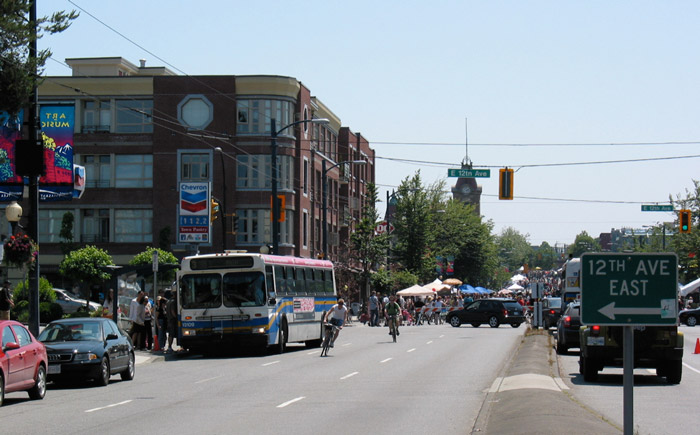
I get around everywhere by bike, public transit and on foot. So when my mayor presented the Mayors’ Council plan during a HUB committee meeting, I was super excited. More SeaBus? B-Lines in my neighbourhood? Bike lanes? YES!
All this and more needs to be funded somehow. There’s a lot of fact-slinging, grumbling and even partying happening, so I thought I’d offer my own personal reasons for supporting the plan. And some info along with it.
Here’s why I’m voting YES:
1. Safe cycling paths are the best!
More safe cycling paths means cyclists like myself — and those usually less comfortable riding in the city — can get to their destinations more easily. 2700 more kilometres of bike paths will encourage more people to take up cycling as a convenient, fast, safe and fun way to get around. Check out my 6+ reasons why bikes are good for Vancouver.
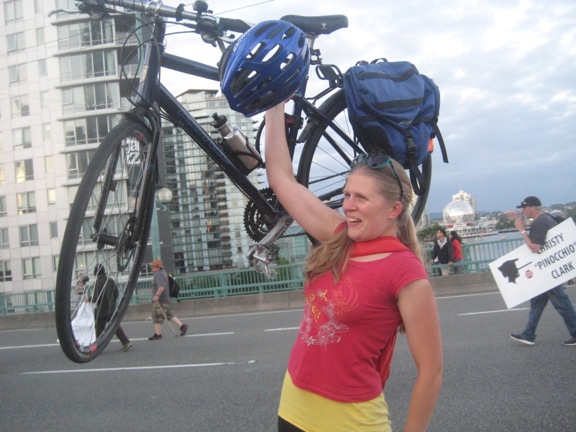
I’m this excited. (Photo by Pia Massie)
2. 50% more SeaBus service, woo!
10-minute SeaBus service at peak times at 15-minute service otherwise will literally change my life. It’s so stressful to miss — or almost miss — one, especially when buses in my neighbourhood often fail to make this critical connection at rush hour. More frequent SeaBus means more freedom in our schedules. I’d hardly need to look at the time. Leave when you want, and you won’t have to wait long. I think this will be a huge draw for people who currently deal with backed-up bridge traffic. Speaking of which…
Continue reading 8 reasons why I’m voting YES in the transit referendum »
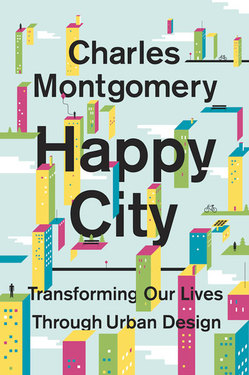
I felt sad when I finished reading “Happy City” the other day. Vancouver author Charles Montgomery weaves together stories, interviews, culture and information in such a compelling way that I felt like a month-long conversation had ended. When I began reading it, I gushed about it on Facebook and with good reason. It has something for any city dweller — from the history and science of happiness and behaviour, to impacts of transportation on wellbeing, to dwelling types influencing social interaction. I returned it to the library reluctantly after my initial 14-day restricted loan period was up, and waited anxiously to get it back until another copy was returned six days late. (I guess the other person liked it even more than I did.) I felt its absence like a close friend.
Continue reading What makes a Happy City? »
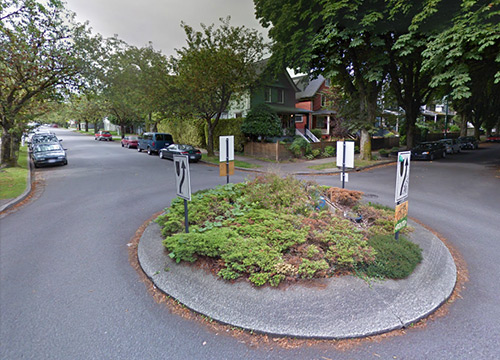
Gather Round Roundabout at St George St at East 10th Ave. Image from Google Streetview.
A few years ago I wrote about a Mark Lakeman event, which I did not attend, so my interest was piqued when a friend of mine mentioned an upcoming event with Lakeman’s name on it.
“Cracks in the pavement: Placemaking and the remaking of the modern city with Mark Lakeman” (tickets still available at Eventbrite) will be Lakeman’s public talk this Friday evening “on Placemaking and Redesigning The Commons” ahead of a 9-month course on the subject.
Placemaking, the creative reclamation of public space was the brainchild of Mark, an urban designer, and his neighbours in 1996 when they transformed their own intersection into a place for community gatherings and interaction — starting a mini revolution in Portland, OR that has spread throughout the city and inspired the creation of City Repair, an organization that engages citzens in transforming places. (Read more.)
Continue reading What is placemaking anyway? »
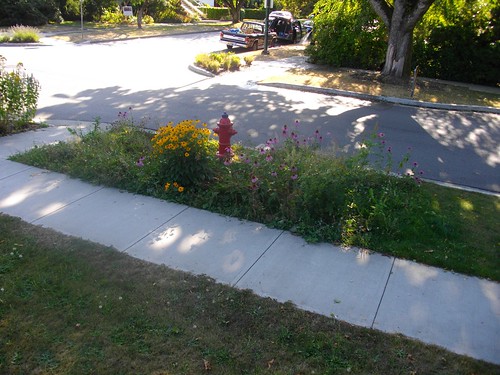
The garden is greener on the other side of the road. (Photo by
urbanwild via Flickr)
I thought I’d alert you dreamers, makers and thinkers to some upcoming events in Vancouver.
This should be an interesting month, with David Owen speaking Thursday on why Manhattan is the greenest city, and if Portland isn’t, Mark Lakeman is sure to prove they’re ready to take the lead.
“Eco-Dreaming Vancouver!” with Mark Lakeman, City Repair Co-Founder, Portland
Friday, March 25, 7:30pm – 9:30pm
Join us for Mark’s “The Village Lives” presentation on how Portland is rapidly becoming the USA’s leading green city!
Saturday, March 26, 10am – 5pm
Join us for a day of Collaborative and City Repair Games facilitated by Mark Lakeman, Power of Hope and Village Vancouver. We will spend the day building community, having fun, and learning how to work as “villages” to ecologically re-design and retrofit our neighbourhoods. Registration 9:30 am. Please RSVP for Saturday workshops to: sara[at]powerofhope.org
Location: W2 Storyeum, 151 West Cordova
Cash bar and lunch service available by W2 Catering.
More information and register by donation at ecodreamingvancouver.eventbrite.com
Thanks to Sara Dent.
Continue reading Upcoming: Mark Lakeman, Natalie Purschwitz and SUSTAIN: Vancouver »

Photo by
Snurb via Flickr
While searching for articles more in-depth on the first issue here, I came across some interesting finds. If you can read between the lines, you’ll figure out my headline. (Unintentional cheesy rhyming.)
The nuclear plant explosion caused by Japan’s magnitude 8.9 earthquake, and potential of further danger, reminds us just how risky and costly nuclear power is, says Greenpeace. Writes Ariel Schwartz for GOOD, “Nuclear power plants aren’t cheap, either. Reactors cost billions of dollars to build, which is why there are only 104 operating in the entire country [US] and why they’re all old — all of these plants began construction in 1974 or earlier.” And I think we can all agree a wind or solar farm is far more attractive than a nuclear power plant. Speaking of solar farms, this farmer is harvesting the sun along with his wheat.
Continue reading What do climate change, farming and hipsters have in common? »
I love GOOD Magazine for their content and design. I got a little emotional at work recently when I opened fifteen of their website’s articles just from their bottom-of-the-page grid — probably 95% of the content there. Inspired by their new “Overload” articles where an author with a similar habit to me — link-happy without enough time/energy to read everything in a day — posts snippets with links to interesting articles, here’s my first one. I might do this again later when I have lots to share but need to get my post out the door quickly.
Candy Chang is amazing. She’s started a community engagement project that uses stickers to enable people to imagine how neglected parts of New Orleans could be revitalized. You don’t have to be an urban planner to hope and dream about change in your community.
We’ve been saying all along that living sustainably is good for the economy too, and the New York Times reports that the Clean Air Act has benefits to the tune of $2 trillion annually by 2020. Time to leave the car at home more often, especially because sitting in traffic triggers more heart attacks than smoking and alcohol. Smoggy Los Angeles has a new bike plan that will hopefully deal with the pollution along with its street safety.
Continue reading Civic engagement by sticker, L.A. bike plan and other (mostly) good news »
Portland, Oregon has several remarkable traits that make the city liveable and more sustainable.
The city is well-known for its cycling culture — 3.9% of residents make their trip by bicycle, beating out Vancouver at 3% (we’re not even in second place!). With the city’s investment in expanding its current 300+ mile network, they’re bound to shoot ahead. (Copenhagen still takes the cake by a long shot.) Bicycle transportation planner Mia Birk from Alta Planning + Design was recently in Vancouver to show us the quick and successful improvements she was involved in to bring more and safer bike lanes to Portland. The results? More cyclists, fewer crashes, less traffic. Their process involved community engagement as well, which isn’t easy. The city’s mayor, Sam Adams, was here a couple years ago to talk about active transportation in Portland. They take it seriously.
Continue reading Green thinking in cities, Part 6: Portland »
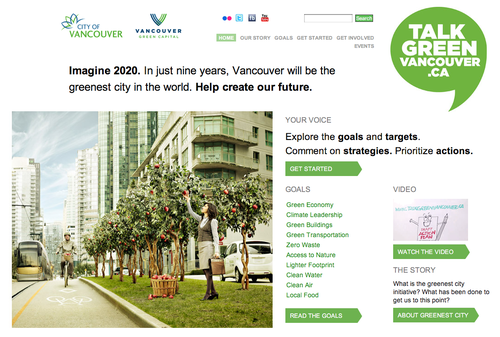
Come collaborate, brainstorm, and meet other green keeners (like me!) at the Greenest City Camp on Saturday, March 5th!
The “unconference” is “a full-day of learning, connecting and finding allies and collaborators to make Vancouver the Greenest City in the world by 2020. This is your chance to connect with Vancouver residents and organizations that are passionate about making this a green city and find out how we can move forward together. It’s about finding people, and the resources, to do what you always wanted to do”, like creating a laneway community garden with your neighbours or reducing waste at work.
If that didn’t already get you stoked, there will be food. Mmm, food! the connector of people.
And there’s more…
If you’re baffled by camp idea, sign up anyway and check out this camp prep webinar March 3.
The Greenest City Webinar on March 4 is kind of a “The Plan: 101” so if you’re not up to speed on this (which you should be, cos it’s awesome and exciting), this is your chance to sit back and get educated before the unconference.
And there are a couple zero waste events on March 2nd, with more info on the Talk Green Vancouver events page.
Now go register for the unconference!
 This daily green blog challenge is in celebration of David Suzuki’s 75th birthday, supporting the David Suzuki Foundation. Please help me out by sponsoring me online now.
This daily green blog challenge is in celebration of David Suzuki’s 75th birthday, supporting the David Suzuki Foundation. Please help me out by sponsoring me online now.
Note: I am writing solely on my own behalf, and do not claim to represent the David Suzuki Foundation or its views here.
Curitiba, Brazil, has recently become a major influence on sustainable transportation in cities, but it was in 1972 that they introduced their first pedestrian street (video). Implemented within three days, the quick street closure stirred up controversy but resulted in a loved public space — a process familiar in many of its modern counterparts. That was just the beginning for this South American metropolis.
While Vancouver has been busy building and expanding expensive metro systems, Curitiba has been attracting incredible ridership to their highly efficient and frequent Bus Rapid Transit system.
The bus system of Curitiba, Brazil, exemplifies a model Bus Rapid Transit (BRT) system, and plays a large part in making this a livable city. The buses run frequently — some as often as every 90 seconds — and reliably, and the stations are convenient, well-designed, comfortable, and attractive. Consequently, Curitiba has one of the most heavily used, yet low-cost, transit systems in the world. — Urban Habitat
Continue reading Green thinking in cities, Part 3: Curitiba »
I’m not all that surprised to learn that the results of a study shows gym class helps kids read better.
At the end of the article, after pointing out that the school studied has a lot of financial support available, Dwyer asks, “If getting in some exercise before starting school really does boost academic performance, what would it take to have fitness facilities like Naperville’s in high schools labeled as dropout factories?”
Continue reading Better education through urban planning »





 The garden is greener on the other side of the road. (Photo by
The garden is greener on the other side of the road. (Photo by  Photo by
Photo by 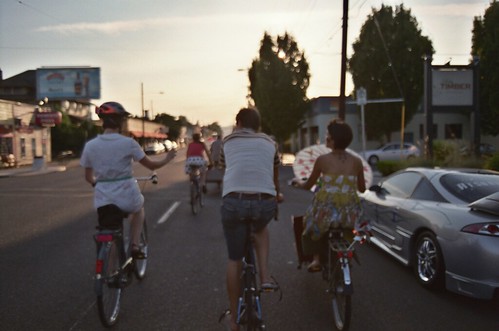
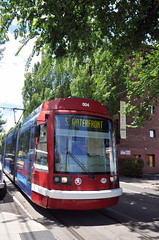


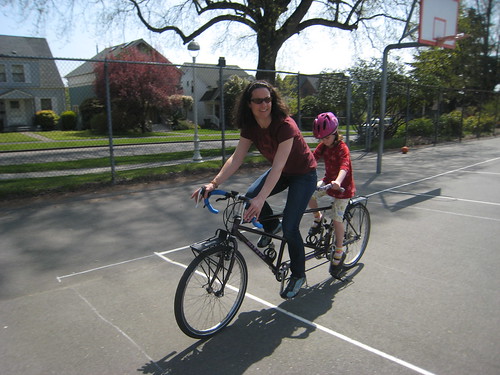 Photo by
Photo by